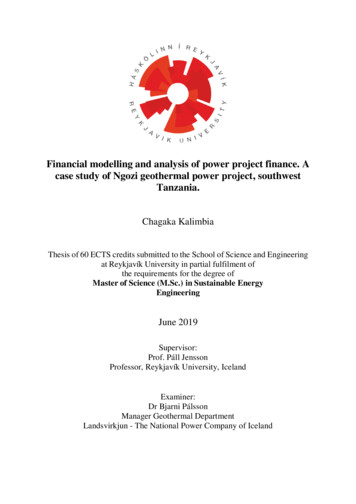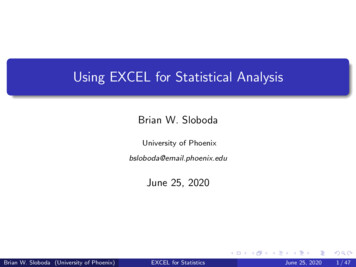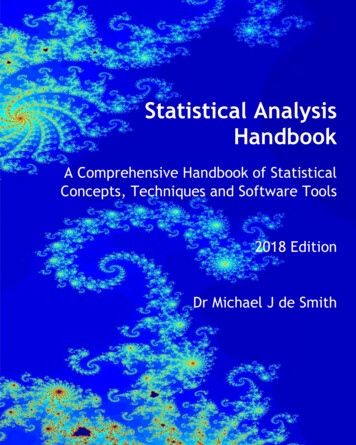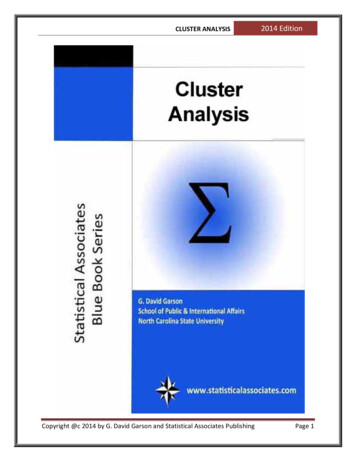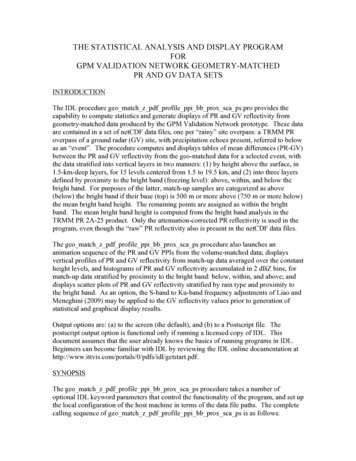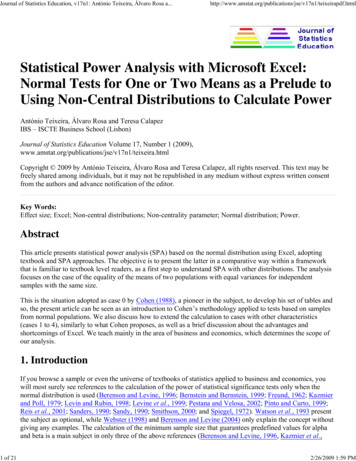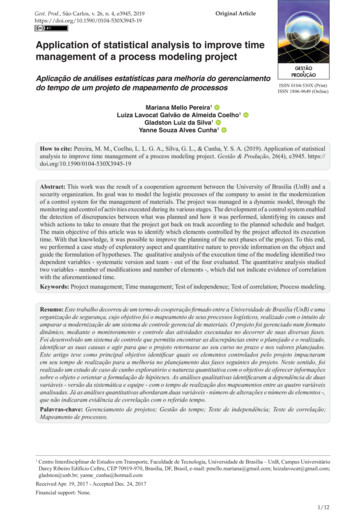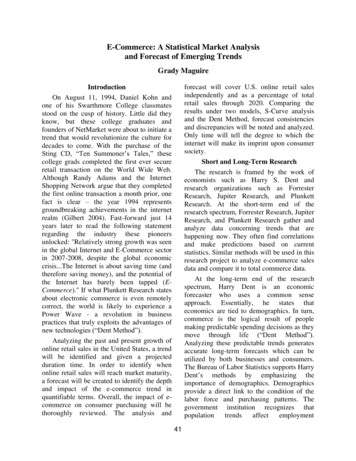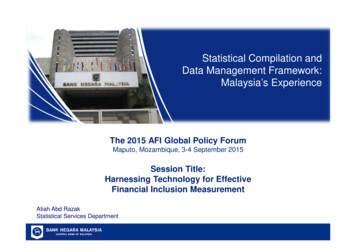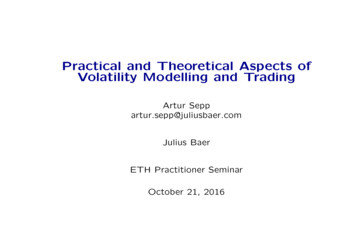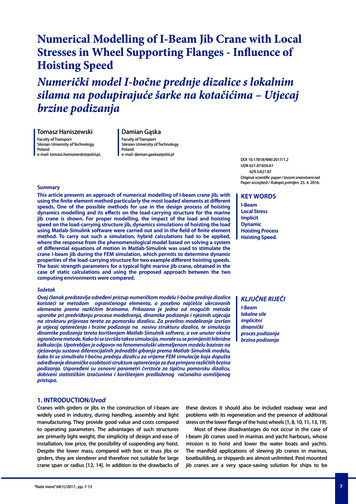
Transcription
aftData Analysis & StatisticalModelling for BusinessDrCourse overviewWe welcome ideas to improve these course materials.Please email suggestions to coursematerials@agsm.edu.auDASM 2016
aftDr
ContentsCourse calendarSession 1, 201611Course outlineCourse contentsLearning outcomes225Assumed knowledgeAssumed Excel knowledgeAssumed Mathematical smentAGSM assessment policyAssessment 1 – Multiple Choice questions (MCQs)Assessment 2 – Group assignmentAssessment 3 – Examination1414141415List of Statistical Symbols16AcknowledgementsCourse coordinatorContributors171717DraftLearning technologyYour resourcesEquipment you will needIMPORTANT: StatToolsTM add-in: Installation of softwareApple Mac UsersTablet compatibilityStatToolsTM help desk supportDiagnostics add-in: Installation of softwareSaturday workshopsExamples in the course materialExercises with Downloadable SolutionsGroup workOn-line materialsUNSW IT Service CentreThe AGSM eLearning CoordinatorExternal TELT Service CentrePodcasts and ScreencastsFurther readingOther resources[
aftDr
Course calendarSession 1, 2016Data Analysis & Statistical Modelling for BusinessMBA (Executive)Weekno.Week begins UnitAssessment due (% weighting)Student ResponsibilitiesMultiple Choice Questions (MCQs)Assessment value (25%)Download course files from Moodle to yourTMhard disk. Install StatTools Excel add-in.Read Student Overview (SOV) material.Unit 1 MCQs openthSaturday 13 February and close Fridayth19 FebruaryBegin arranging groups (Maximum 4) forthe Group Assignment. Group Assignmentavailable on Moodle.1 FebruarySOV18 February1215 February2Unit 2 MCQs open Saturday 20thFebruary and close Friday 26 February322 February3Unit 3 MCQs open Saturday 27thFebruary and close Friday 4 March429 February4Unit 4 MCQs open Saturday 5 Marchthand close Friday 11 Marchaft0thththWorkshop 1 (Saturday 5 March) Refer to course notes.th7 March5Unit 5 MCQs open Saturday 12 Marchthand close Friday 18 March14 March6Unit 6 MCQs open Saturday 19 Marchthand close Friday 25 MarchDr5th6th721 March7Unit 7 MCQs open Saturday 26 Marchstand close Friday 1 April828 March8Unit 8 MCQs open Saturday 2 April andthclose Friday 8 April94 April9Unit 9 MCQs open Saturday 9 April andthclose Friday 15 AprilthEaster Friday 25 MarchInstall the Diagnostics add-in from yourHard Disk. See Software InstallationInstructions. The Diagnostics add-in willbe needed in Unit 7 and beyond.ndthWorkshop 2 (Saturday 9 April) Refer to course notes.th1011 April10Unit 10 MCQs open Saturday 16 Aprilndand close Friday 22 April1118 April11Unit 11 MCQs open Saturday 23 Aprilthand close Friday 29 April1225 April12rdGroup Assignment due (25%) Monday18th April before 9:30am (AEST).Group Assignment with model solutionsreturned.Practice Exam Questions in Unit 12Final Exam 50% (Saturday 7 May)Course Overview1
Course outlineData Analysis & Statistical Modelling for Business explores possibilities inusing statistical data for creating models to assist managers make decisions.This course develops expertise in a standard set of statistical and graphicaltechniques, which will be useful in analysing business related data. Thesetechniques are widely applied in a number of areas of management,including operations, sales and marketing, strategy, finance and economics.The course provides a change in mindset from ‘statistics can be used toshow anything’ to ‘statistics provides a methodology to manage uncertaintyand explain variation’.aftCourse contentsDrThe course aims to encourage you to think statistically. Two simple wordsdescribe this capability in managers; the ability to “understand variation”.The course will encourage you to develop your abilities to understand anduse data. It is designed to equip managers with the quantitative skills tomake effective use of statistical data in the business workplace, to developexpertise in a standard set of statistical and graphical techniques which willbe useful in analysing data, and to learn to apply these techniques in anumber of areas of management. It is intended that you will leave thecourse with an ability to use statistical software to analyse data, and aboveall, with a good understanding of how to describe and model complexbusiness relationships using regression analysis.The units in this course are organised into five sections:1. The FoundationsUnit 1, Summarising and Visualising Data introduces you to the basicgraphical and statistical methods used to analyse one variable, in laymen’sterm a column of data in a spreadsheet. It also introduces you toStatToolsTM, the statistical package used throughout the course to do thenumber crunching. These basic skills are not only very important in thecourse but are directly transferable to the design of management reportsback in the workplace. The unit introduces the key concept of variation indata, how to summarise and visualise it with the aim of identifying patterns.Unit 2, The Normal Distribution introduces you to arguably the mostprevalent probability distribution in statistics, the normal distribution orbell-shaped curve as it is often called. Most statistical methods are based onthe concept of probability so the unit begins with the concept of acontinuous probability distribution. It extends this concept to the normaldistribution and examines the empirical rules which describe how dataappears when it is normally distributed. Whilst more theoretical than otherunits, this unit provides the fundamentals for the business applications of2Data Analysis & Statistical Modelling for Business
statistical tools throughout the course. The unit introduces the key conceptof the Central Limit Theorem which allows us to draw conclusions aboutthe business and its activities based on taking samples and recording data.Many management problems involve sampling, such as studying samples ofcustomers or calls from a service desk or invoice errors and inferring whatmight be happening in the bigger picture.2. Performance and Business ProcessesaftUnit 3, Monitoring Business Processes: Part 1 introduces the methods formonitoring the performance of business processes. Since companies arecomposed of processes that deliver and support products and services,collecting data in terms of quality, cost and speed of these processes is animportant business activity. Part 1 examines methods when the data iscontinuous such as lead time or financial data or in the case of productparameters measures of weight, length and density.Unit 4, Monitoring Business Processes: Part 2 extends the methods forcontinuous data to discrete and categorical data. Examples includemonitoring defects, production and sales volumes, customer complaints,work injury rates and yes/no outcomes. The data in such cases will appear ascounts, proportions or percentages.DrUnit 5, Hypothesis Testing and Confidence Intervals allows a manager tocompare the performance of different machines, people systems, offices andother elements. The unit introduces the concept of statistical significance,a concept which is central to determining through objective meanswhether one set of numbers is more often than not, higher or lower thananother set of numbers. The methods in the units are often applied to rootcause analysis to validate through data whether suspected root causes ofpoor business performance are actual root causes. Hypothesis testing is akinto problem-solving with data, rather than relying on intuition only, andincreases the likelihood that the manager will select the best option whenresolving an important business issue.3. Building Models in the Search for Improvements inPerformanceUnit 6, Simple Regression Models: Part 1 examines the situation wherethere is single independent variable influencing a single dependentvariable. The key issue is to find out to what extent the independentvariable contributes to explaining the variation in the dependent variable.A practical context is attempting to investigate the relationship betweenbottom-line results and employee engagement scores. The unit introducesthe key concepts of correlation and line of best fit. The unit also addressesthe situation where the independent variable is a categorical variable suchCourse Overview3
as a “Yes-No” occurrence. For example the manager may be interested indiscovering whether customer satisfaction differs for a new customer (codedNew Yes) versus an existing customer (coded New No).Unit 7, Simple Regression Models: Part 2 extends the previous unit tocases where there are unusual data known as outliers and leverage points.These are known in business as anomalies or special causes and theirpresence can impact a regression model in adverse ways. The unit alsointroduces the role of transformations especially the use of the logarithmicfunction. A price-elasticity problem common in economics is used toillustrate the impact of transformations.aftUnit 8, Multiple Regression Models: Part 1 examines the situation wherethere are multiple independent variables influencing a single dependentvariable. The key issue is to find out to what extent each independent variablecontributes to explaining the variation in the dependent variable. A practicalcontext is attempting to explain bottom-line results from knowledge ofcustomer preferences and employee engagement levels. The unit introducesthe key concept of multicollinearity where the independence assumption ofindependent variables is violated. The unit starts with a polynomial regressionmodel to demonstrate how curvilinear models may be constructed.DrUnit 9, Multiple Regression Models: Part 2 extends the basic model ofmultiple regression to cover (a) analysis of leverage points and outliers and(b) variable selection methods. The latter methods produce the mostpowerful model with the least number of variables. The unit introduces thekey concept of model parsimony, or ‘explaining the most with the least’.Managers find model parsimony a useful concept when the cost of datacollection is high since it means they can identify and monitor the mostimportant data for their business without wasting resources on collectingdata that is not useful for decision-making.4. Modelling Performance over Time: When ‘Yesterday’Impacts ‘Today’Units 10 and 11, Time Series Models: Parts 1 and 2 extend regression analysisto cover time series models. These units are particularly relevant for managerstracking their company’s performance, both in financial and non-financial terms,over time. A direct application of time series models is sales forecastingparticularly where trends and seasonality are present. The units introduce the keyconcept of autocorrelation, meaning today’s results are impacted by yesterday’sresults. The units improve the capability of managers in the area ofunderstanding and forecasting Key Performance Indicators (KPIs). Unit 10covers the situation where no trend and seasonality are present, while Unit 11covers the more complex situation where they are present.4Data Analysis & Statistical Modelling for Business
5. Practice Exam QuestionsUnit 12, Practice Exam Questions provides an opportunity for students toreflect on the key concepts in Units 1–11. It provides a lengthy list of exampractice questions and solutions. These will provide an opportunity forstudents to more thoroughly understand the expectations of the exam and testtheir knowledge of the course content.Learning outcomesWhen you have completed this course you should be able to:Appreciate that the collection and statistical analysis of data improvesbusiness decisions and reduces the risk of implementing solutions thatwaste resources and effort. Select and deploy the correct statistical method for a given dataanalysis requirement. In particular, develop expertise in describing data,process management, hypothesis testing and model building. Achieve a practical level of competence in building statistical modelsthat suit business applications. Recognise, develop and distinguish between models for cross-sectionalanalysis at a single point in time and models for time series analysis atmultiple points in time.Draft Run a statistical software package that integrates with Excel andinterpret its output. Increase your capability as a manager to “think statistically” using dataand use this capability to support your business intuition.Build sufficient skills to provide leadership in statistical methods for thestaff in your area of responsibility. MBA Program Learning GoalsThe Course Learning Outcomes are what you should be able to DO by theend of this course if you participate fully in learning activities andsuccessfully complete the assessment items.The Learning Outcomes in this course also help you to achieve some of theoverall Program Learning Goals and Outcomes for all postgraduatecoursework students in the UNSW Business School. Program LearningGoals are what we want you to BE or HAVE by the time you successfullycomplete your degree (e.g. ‘be an effective team player’). You demonstratethis by achieving specific Program Learning Outcomes – what you are ableto DO by the end of your degree (e.g. ‘participate collaboratively andresponsibly in teams’).Course Overview5
MBA Program Learning Goals and OutcomesLearning Goal 1: Business Management KnowledgeStudents should be able to identify and apply current knowledge of disciplinary andinterdisciplinary theory and professional practice to general management andbusiness within diverse situationsLearning Goal 2: Critical ThinkingStudents should understand and be able to identify, research and analyse complexissues and problems in business and develop appropriate solutionsLearning Goal 3: CommunicationaftStudents should be able to produce written documents and oral presentations thatcommunicate effectively complex disciplinary ideas and information for theintended audience and purposeLearning Goal 4: TeamworkStudents should be able to participate collaboratively and responsibly in
Install StatTools. TM Excel add-in. Read Student Overview (SOV) material. 1 . 8 February : 1 . Unit 1 MCQs open Saturday 13 th February and close Friday 19 th February Begin arranging groups (Maximum 4) for the Group Assignment. Group Assignment available on Moodle. 2 : 15 February . 2 : Unit 2 MCQs open Saturday 20 . th February and close Friday 26 th February . 3 : 22 February . 3 : Unit 3 .
